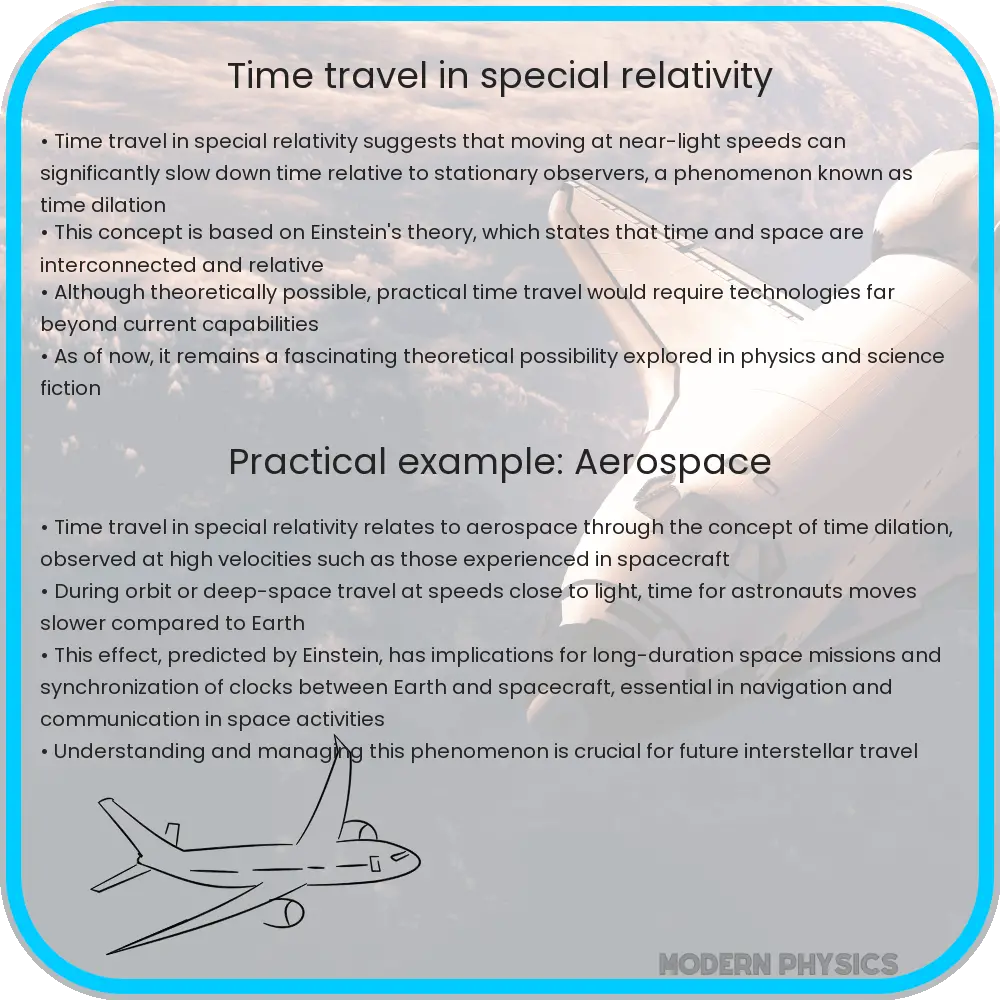Time travel in special relativity explores the impacts of speed on time perception, focusing on paradoxes like the Twin Paradox, and the theory’s fundamental principles.

Time Travel in Special Relativity: Paradoxes, Speed & Theory
Time travel has long fascinated scientists and the general public alike, often leading to captivating narratives in science fiction. However, time travel also has roots in serious scientific inquiry, especially within the framework of special relativity, a theory developed by Albert Einstein in 1905. To understand the concept of time travel through special relativity, we need to delve into some fundamental principles, paradoxes, and theoretical implications.
Special Relativity Basics
Special relativity is built on two primary postulates:
- The laws of physics are the same in all inertial reference frames (which means they are consistent for any observer not experiencing acceleration).
- The speed of light in a vacuum is constant and does not change irrespective of the observer’s motion or the source of the light.
These principles lead to surprising outcomes, particularly concerning how we perceive time and space. One of the critical consequences of special relativity is the phenomenon of time dilation.
Time Dilation
Time dilation refers to the effect whereby time slows down for an object moving close to the speed of light relative to an observer at rest. This can be expressed mathematically using the Lorentz factor (γ), given by:
\(\gamma = \frac{1}{\sqrt{1 – \frac{v^2}{c^2}}}\)
Here, \(v\) is the velocity of the moving object, and \(c\) is the speed of light. As \(v\) approaches \(c\), \(\gamma\) increases, meaning that time for the moving object slows down compared to the stationary observer.
This is not just a theoretical prediction; it has been experimentally verified numerous times, such as in experiments involving particle accelerators where particles traveling near the speed of light exhibit longer lifetimes than when at rest.
Paradoxes of Time Travel
The Twin Paradox
One of the most famous thought experiments illustrating time dilation is the Twin Paradox. Consider two twins: one stays on Earth while the other travels to a nearby star at speeds close to the speed of light and then returns. According to special relativity, the traveling twin’s clock runs slower due to high velocity, so the traveling twin ages less than the twin who stayed on Earth.
When they reunite, the traveling twin will be younger than the Earth-bound twin, seemingly having traveled into Earth’s future. This paradox has been resolved within the framework of special relativity, showing that it’s not a true paradox but rather a consequence of the difference in inertial and non-inertial (accelerated) frames of reference.
The Grandfather Paradox
Another commonly cited paradox in discussions of time travel is the Grandfather Paradox. This involves traveling back in time and preventing one’s grandfather from meeting one’s grandmother, thus preventing the time traveler’s birth. This paradox highlights potential inconsistencies or causal loops in backward time travel but is more applicable in discussions of general relativity and quantum mechanics rather than special relativity.
Speed and the Light Barrier
One critical aspect of special relativity is that it enforces a cosmic speed limit: nothing can travel faster than the speed of light in a vacuum, \(c\). As an object approaches the speed of light, its relative mass increases, requiring more and more energy to accelerate further:
\(E = \gamma m_0 c^2\)
Here, \(E\) is the total energy, \(m_0\) is the rest mass, and \(\gamma\) is the Lorentz factor. This equation implies that it would take infinite energy to reach or exceed the speed of light, making it impossible for any material object with mass to achieve or surpass this speed.
Concepts of Causality and Time Travel
In special relativity, causality—the idea that cause precedes effect—is fundamental. Faster-than-light (FTL) travel would violate causality because it would lead to scenarios where effect precedes cause, creating paradoxes. For instance, if signal communication were possible faster than light, one could theoretically send a message to the past, disturbing the causality chain.
While special relativity doesn’t allow for FTL travel or retrograde time travel (moving backwards in time), it opens up fascinating discussions about the nature of time and possible technologies in science fiction, such as wormholes and warp drives. These hypothetical structures are primarily rooted in general relativity, which extends beyond the scope of special relativity and involves the curvature of spacetime itself.
Experimental Evidence of Time Dilation
Over the years, various experiments have validated the time dilation predictions of special relativity:
- Mossbauer rotor experiments: Utilizing the Mössbauer effect, scientists observe relativistic time dilation in rotating systems, consistent with theoretical predictions.
- GPS satellites: Time dilation must be accounted for when using the Global Positioning System. The clocks on the satellites move faster than those on Earth’s surface due to differences in both gravitational potential (general relativity) and relative velocity (special relativity).
These empirical confirmations substantiate that time dilation isn’t merely a theoretical construct but a physical phenomenon observed in our universe.
Conclusion
Special relativity, with its profound implications for time and space, unveils the potential and limitations of time travel. The theory’s postulates demystify exotic concepts like time dilation and establish a universal speed limit, beyond which conventional physics ceases to apply.
The intriguing paradoxes, such as the Twin Paradox and the Grandfather Paradox, challenge our understanding of time and inspire further inquiry into the nature of reality. While special relativity sets fundamental constraints, it also opens the door to broader explorations within the realm of general relativity and quantum mechanics, fuelling the imagination of both physicists and science fiction enthusiasts alike.
The journey through special relativity is a voyage through the fundamental principles that govern our universe. As we continue to explore and understand these concepts, we move closer to answering some of the most profound questions about time, space, and the very fabric of reality.
